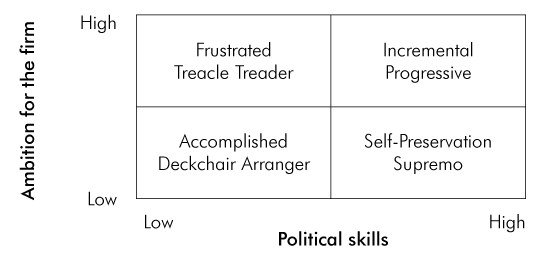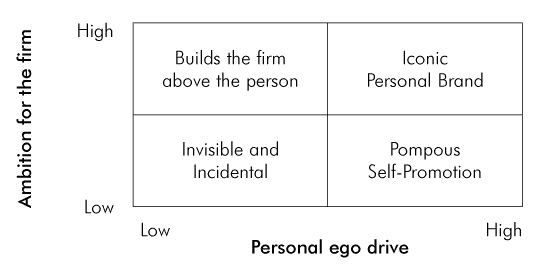 |
Some Observations on Law Firm Leaders |
Over the past 20 years, I have observed a range of leaders and leadership styles in professional service firms. Over this same period, there has been an exponential increase of interest in the subject of leadership, and the crucial role that it plays in the success (and occasionally the failure) of law firms. This case study consolidates these observations and suggests a descriptive framework aimed at increasing understanding and effectiveness in this area. Professional respect as a driver of behaviour Dimensions that shape behaviour
From these, a model can be constructed which highlights four behavioural types, each of which is explained in more detail further in this case study.
The ‘Accomplished Deckchair Arranger’ This is the leader with negligible political ability and a low ambition for the firm. On the face of it, it is puzzling that such a psychotype could ever figure in an analysis of law firm leadership. In fact, there are many examples of the ‘Accomplished Deckchair Arranger’ prospering (and indeed being sought out as a future leader) in law firms everywhere. From the perspective of other partners, these types have two great advantages: they do the administrative work that no one else wants to do, and they don’t try to interfere with the status quo. They are harmless, likeable and non-threatening. This quadrant is typified by the leader whose focus is on the operational efficiency of the firm’s back office. Their forays into management will impinge on practice areas, but only insofar as it does not affect the preferred working practices of the partner group. While the ‘Deckchair Arrangers’ may have personal ambitions, their drive to develop their firm is not so great so as to risk confronting unhelpful behaviours. In other words, they are not political This is not to say that the firm will not grow or be seen as ambitious from the outside. The key point is that, in this sort of organisation, ambition flows from individual partners and a culture which demands progress. Indeed, for some firms in this category, the collective will of the partnership acts against the election of anyone who may attempt to usurp their personal ambitions for one that is more cohesive and (necessarily) directional. Finding themselves mired in negotiations, filibustered at meetings and frustrated, they perceive a partnership ranged against them; doing everything possible to slow the rate of progress and minimise the impact of any changes on their personal position. The ‘Treacle Treader’ has a view of the sensibilities and sensitivities of the partner group as a whole, and realises too late in their often short-lived reign, that raw ambition alone (even when coupled with a formidable intellect and determination to make progress), will never be enough to overcome a partnership steeped in historic norms.
Over time, they exert an iron-grip of control, which is reinforced by the stories and folklore of the organisation recounting the demise of those who have been challenged in the past. Fawning acolytes reinforce the position of these benevolent dictators whose firms or practice groups seldom prosper, but seldom crash either. They simply bumble along, underperforming their apparent peers, but surviving nonetheless in a steady sort of way. In truth, this is the most damaging behavioural type for the long-term future of the firm, because these leaders have tremendous staying power. They may not be the right person for the job (and this may be clearly apparent to everyone involved), but they take some shifting.
Yet, it is the ‘Incremental Progressive’ who has the intellectual and personality tools to make real and enduring changes within their firm, to build a string brand, and to provide a legacy for their successors. Their combination of ambition and political sense means that they are able to glide over the treacle that so encumbers the less savvy yet ambitious, but without stooping into the self-aggrandising approach of those focused on the perpetuation of their personal position.
So what are the implications of this research for law firms? By mapping ambition for the firm against personal ego drive, it is possible to construct a model, which helps to explain how these traits can impact on the personal brand of the leader, as well as the likely success of the firm. Of course, the reader with knowledge of the market will be able to think of law firm leaders who could be placed in each of the quadrants, but the purpose of this article is not to poke fun or embarrass, but to highlight the impact of these traits on the current and future success of the business.
‘Invisible and Incidental’ The ‘Invisible and Incidental’ leaders are most notable for their anonymity, and act as fringe players, played out by the ‘super egos’ in their firm or practice group. For their organisations, success or failure happens in spite of their presence, rather than because of any active involvement that they have had in shaping its future direction and driving its implementation.
Smart firms now recognise that there can be no place for these personalities in their leadership teams, regardless of their abilities as lawyers, if the firm is to prosper in the longer term.
The longer-term question for the organisation is how much of this success is viewed as ‘stand-alone’, and how much is inextricably linked to the persona of the leader. Confidence (both individual and collective) is an important issue in driving the performance of a law firm; a misplaced belief that success can only be achieved with the current leader can be a huge impediment to progress in the early days of any subsequent regime. The question is always, ‘What happens next?’ The smart organisation has an eye to succession planning in advance of any impending changes. Continued success of the firm will only be secured if the next incumbent is well prepared and equipped to take the business to the next level of its development.
That is not to say that such leaders will be invisible to the outside world either. In the intrusive and media-heavy world in which law firms operate, they will become known and respected. They will rise to their responsibilities to engage with external media without treating such a platform as their personal ‘soap-box’. They will always (and genuinely) place praise for success at the door of their people and their clients, not because their PR advisers tell them that this is what they should do, but because they genuinely believe it to be the case.
Collective action is needed from the wider governance team to ensure that potential leaders with the required personality traits and behaviours are given the opportunity to develop and utilise their talents, in order to take their firm forward. |
Andrew Hedley |

